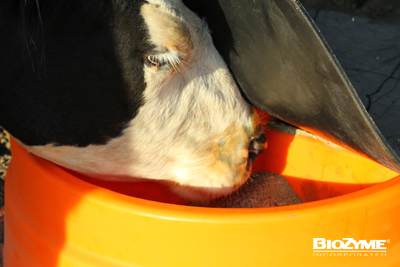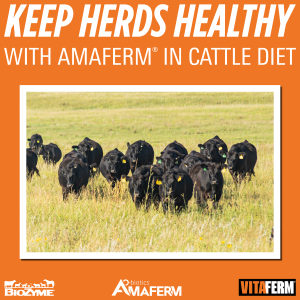Article courtesy of Donald Stotts, Oklahoma State University, donald.stotts@okstate.edu
ENID, Okla. – The occurrence of anaplasmosis has been shown to be more widespread in the United States than once thought, underscoring the need for cattle producers to be aware of causes for and clinical signs of the disease.
 “This past year, confirmed cases of bovine anaplasmosis in the Midwest have reached record levels, and recent evidence of widespread anaplasmosis in Kansas provides reason to believe the disease is likely present in northwest Oklahoma as well,” said Dana Zook, Oklahoma State University Cooperative Extension area livestock specialist for northwestern Oklahoma.
“This past year, confirmed cases of bovine anaplasmosis in the Midwest have reached record levels, and recent evidence of widespread anaplasmosis in Kansas provides reason to believe the disease is likely present in northwest Oklahoma as well,” said Dana Zook, Oklahoma State University Cooperative Extension area livestock specialist for northwestern Oklahoma.
Oklahoma is considered to be endemic, meaning in most parts and especially in the eastern and south-central parts of the state, this disease occurs every year. If anaplasmosis is suspected in a cattle herd, a blood test can confirm its presence.
“One more reason why Extension has always recommended livestock producers invest in a good working relationship with their large animal veterinarian,” Zook said. “The more a veterinarian knows about a specific herd, the more able he or she is to enhance a livestock operation’s herd health management.”
Anaplasmosis is a disease in cattle that causes destruction of red blood cells by bacteria called Anaplasma marginale. Upon gaining entry into a susceptible animal, the anaplasma bacteria slowly invade the animal’s red blood cells.
“After a short incubation period, the animal’s immune system will try to destroy the bacteria,” said Dr. Barry Whitworth, veterinarian and OSU Cooperative Extension food animal quality and health specialist headquartered out of Ada. “In an attempt to rid the body of the infection, the immune system inadvertently destroys the animal’s red blood cells, which leads to the characteristic anemic effects of anaplasmosis.”
Clinical signs of the disease may include weakness, loss of appetite and pale skin around the eyes, muzzle, lips and teats. Later, the animal may exhibit excitement, rapid weight loss and yellow tinged skin. Cattle of all ages can be infected with anaplasmosis.
“Older animals typically will exhibit the most severe clinical signs,” Zook said. “Cattle one to three years of age may exhibit severe clinical signs, but their ability to recover from the disease is more likely than older animals. Data indicate that 30 percent to 50 percent of infected cattle more than three years of age will die without early treatment.”
It is important to note that calves younger than one year may become infected but rarely exhibit clinical signs. Animals that recover from the disease will be carriers for life and calves born to these animals also will carry the disease. Anaplasmosis can be spread by the transfer of blood from an infected animal to a susceptible one.
“While some producers may be quick to blame horn flies, stable flies and mosquitos, the main vectors in transmitting anaplasmosis are horse flies and ticks,” Whitworth said. “The greatest issue in terms of control is that common external parasite treatments for cattle are not particularly effective against these species.”
In short, widely used insecticide ear tags that are effective in deterring ear ticks and horn flies are nowhere near as effective against horse flies and ticks that transmit anaplasmosis.
“Sprays and pour-on insecticides work far better for tics but all insecticides only provide very brief control of horse flies,” said Justin Talley, OSU Cooperative Extension livestock entomologist and entomology researcher. “Some pyrethroid insecticides have been shown to repel horse fly feeding immediately after application but it will be short lived.”
Talley and Zook added that data from a recent fly control demonstration in Alfalfa County confirmed monthly application of sprays and pour-on insecticides is necessary for effective control of external parasites.
“Anaplasmosis also can be transferred by instruments contaminated with anaplasma-infected blood, often during dehorning, tagging and castration procedures,” Zook said. “The repeated use of unclean needles in vaccination and treatment procedures also can contribute to transmission.”
Tetracyclines are labeled by the U.S. Food and Drug Administration to combat bovine anaplasmosis in the United States. In the past, a commonly utilized control method was to feed chlortetracycline (CTC) to cattle in combination with a free-choice mineral.
“This common practice can still be utilized but be aware it will require a veterinary feed directive for inclusion in feed or mineral as of January 1,” Zook said. “Producers need to be aware that treating cattle for anaplasmosis can be complicated.”
Animals exhibiting severe clinical signs of the disease are at risk of sudden death if excited because of their reduced red blood cell count and reduced oxygen carrying capacity. Furthermore, treatment for cattle exhibiting severe signs of anaplasmosis will not necessarily alter the course of the disease and may actually prolong clinical symptoms.
“Cattle not yet severely affected may benefit from treatment of an injectable oxytetracycline,” Whitworth said. “A vaccine is available for anaplasmosis but it will not prevent infection. However, the vaccine will typically reduce clinical signs caused by anaplasmosis.”
Widespread use of the vaccine has not yet been achieved, largely because of its cost and availability.
Thoughts from BioZyme Director of Nutrition & Technical Sales, Kevin Glaubius
As pointed out in the article, Anaplasmosis is a significant concern to the beef industry. One strategy that has been effective for our customers has been the use of tetracyline. Several VitaFerm products are available with Aureomyacin brand of Chlortetracycline. The products are labeled for use in cattle over 700 lbs. to provide the recommended .5 mg of Chloratetracycline per lb. of body weight and effectively control Anaplasmosis.
If Anaplasmosis is of concern VitaFerm Concept•Aid CTC 3G, VitaFerm Heat CTC 3G and VitaFerm Cattleman’s Blend CTC 3G are all excellent options. It is important to follow label directions and realize that the correct dose is weigh specific. Four ounces fed daily of any of these products provides 750 mg of chlortetracycline, which is the recommended dose for a 1,500 lb cow. Producers should be visiting now with their veterinarian in order to be able to continue to incorporate these products after the Veterinary Feed Directive goes into effect.


